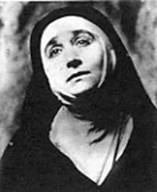
| Next Page |
| About | 
|
By Kitty Davy
I would like to take you back to the year 1911, twenty years before Meher Baba's first visit to the West, and tell you of an interesting story which I feel links up with Meher Baba’s intense activity in relation to the film project, an earlier scenario for which Baba had already laid out the details.
This story of 1911 involves three people; Princess Norina Matchabelli and her first husband, Karl Vollmoeller, and my younger brother, Herbert, age 12, who was not connected in any way with the other two. It was not until Meher Baba drew all three in 1933-34 — to work with Him on the great film project that contact between them was made, and also after two of them, Norina and Herbert, had become Baba's devoted followers. More interesting still is the fact that this incident took place in Hammersmith in London, so near to the Meher Baba Oceanic! What a coincidence!
In 1911-12, more than 60 years ago, there was performed, close to where we stand today, a very beautiful and moving play called "The Miracle". It was played night after night at the Olympia, the biggest covered arena in the world. The cast numbered more than 600 persons.
The Olympia, still in existence, was just across from where I was born and was still living when Meher Baba came to the West on His first visit in 1931 and spent the first night and, later on, other nights with my parents.
No less than 30,000 people descended each day into the Hammersmith tube to reach Olympia. "The Miracle" was hailed as the outstanding event of the 1911-12 theatre season and up until 1917 the play was staged in the major cities of the United States. It was called the most stupendous production in the history of the world.
Many of you may be wondering what the play was about. It was based on an early Christian legend and embraced one of the three great forces moving the human soul — religion, hunger and love — and predominant was that of love. The "miracle" of the play referred to the legend that a statue of the Virgin Mary had come to life to take the place of a young nun who had run away to indulge for seven years in the temptations of the world. The Virgin Mary represented the loving, forgiving Divinity and the young nun represented humanity, blind and ignorant, yet longing to find its way into paradise.
Now, this spectacular pantomime — for pantomime it was, being wordless — had been staged by Max Reinhardt. It had been his dream in 1911 to produce a pantomime, a revival of a type of drama that at the time had been almost forgotten on the Continental stage. He spoke to some of the poets and playwrights of the younger generation who belonged to his circle and one of them, Karl Vollmoeller, was stirred by the suggestion.
They discussed the idea at length and Max Reinhardt mentioned Maurice Maeterlinck's play, "Sister Beatrice", just produced in the West End of London and which was based on the same legend. Max Reinhardt loved the old legend on which the play was based and he asked whether a pantomime could not be evolved out of the theme of the ''Virgin and the Nun". Within a few weeks of their preliminary talks, Max Reinhardt and Karl Vollmoeller got together and the play got off the ground.
| Next Page |